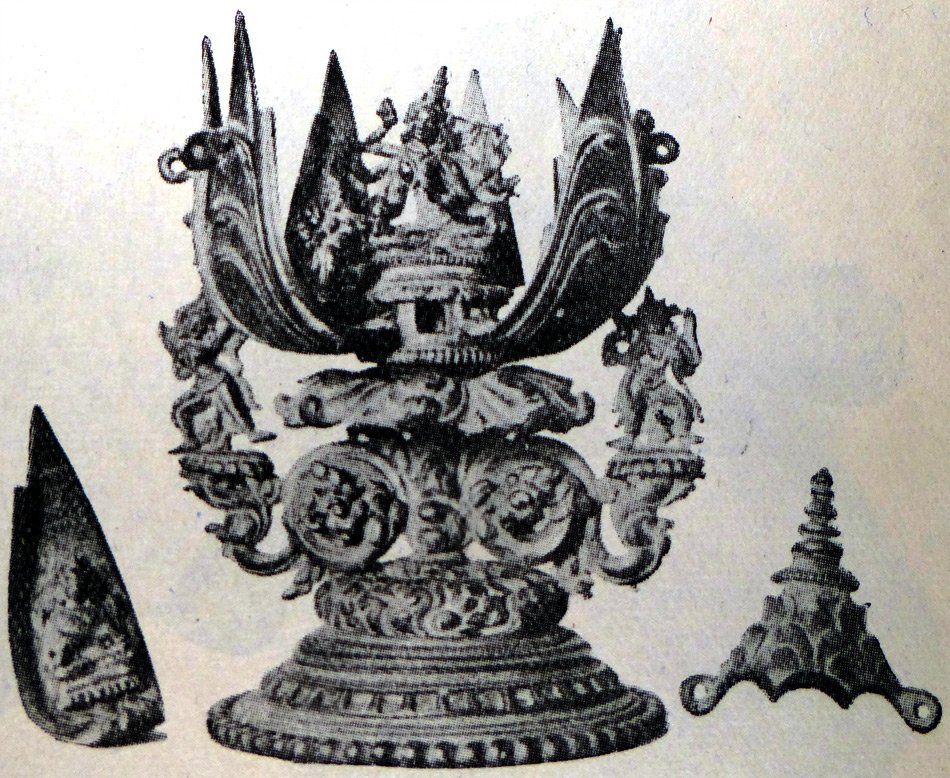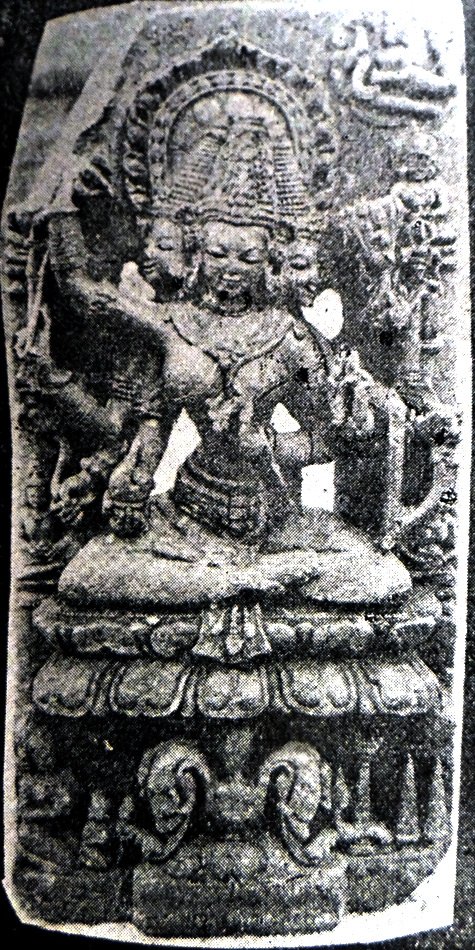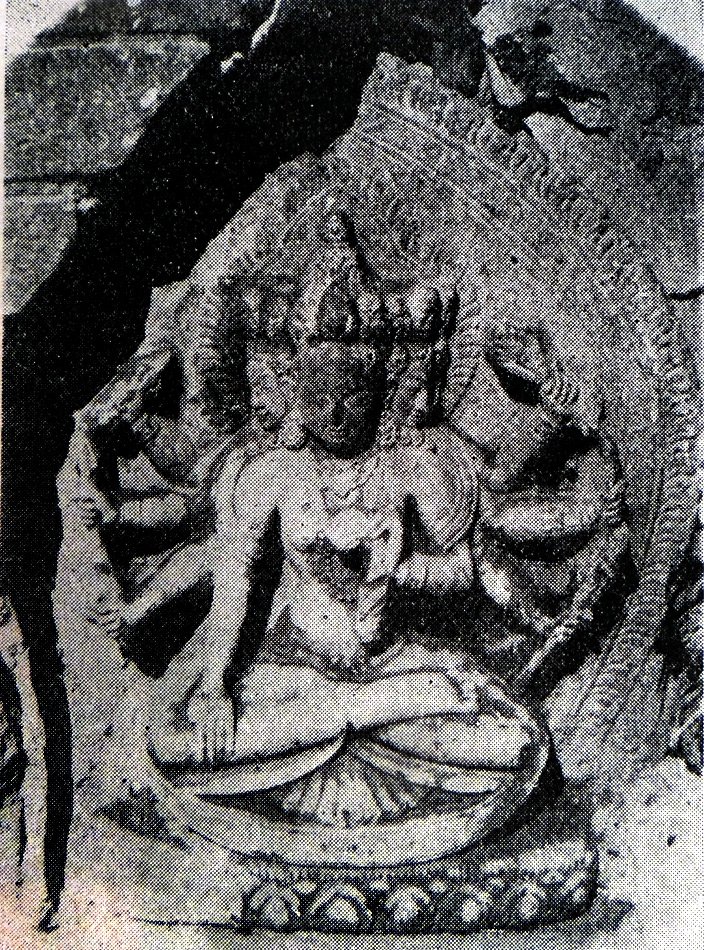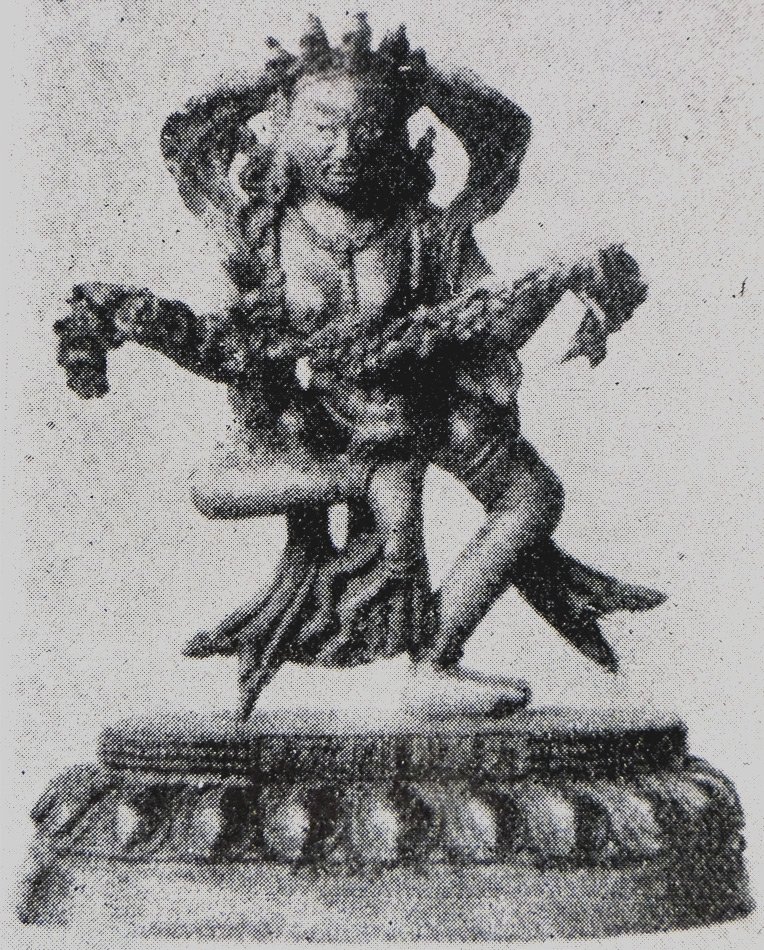The Indian Buddhist Iconography
by Benoytosh Bhattachacharyya | 1958 | 51,392 words | ISBN-10: 8173053138 | ISBN-13: 9788173053139
This page contains an iconography image of Emanations of Ratnasambhava: Vajratara and Pushpatara and represents figure 180-183 of the book Indian Buddhist Iconography, based on extracts of the Sadhanamala English translation. These plates and illustrations represent either photographs of sculptures or line-drawing reproductions of paintings or other representations of Buddhist artwork.
Figure 180-183 - Emanations of Ratnasambhava: Vajratārā and Puṣpatārā
 Fig. 180: Vajratārā (Indian Museum) |
 Fig. 181: Vajratārā (Orissa) |
 Fig. 182: Vajratārā (Nepal) |
 Fig. 183: Puṣpatārā (Peiping) |
Colour: golden yellow;
Faces: four;
Arms: eight.
According to a definite statement l contained in the Vajratārā Maṇḍala of the Niṣpannayogāvalī, the Dhyāni Buddha Ratnasambhava is the spiritual sire of Vajratārā.
She is four-faced and eight-armed and her description is as under:
“Goddess Vajratārā is of golden yellow colour. She is four- faced. The principal face is golden in colour, the right is white, the one behind is blue and the left red. She has eight arms. In her four right hands she shows the Vajra, the noose, the arrow and the conch. In the four left she has the yellow night lotus, the bow, the goad, and the raised Tarjanī”.
Vajratārā is a popular deity in Buddhism and her images are found almost everywhere in India. She is popular also in Nepal. In the Chinese collection of statuettes at Peiping an image of Vajratārā is found under the title of Aṣṭabhujā Vajratārā.
Here, at least one very peculiar image of Vajratārā may be noted. It is in the Indian Museum, Calcutta. The Indian Museum bronze of Vajratārā is in the form of a lotus, and represents the complete Maṇḍala with all the attendant deities. It is so constructed that it can be opened and closed at will. The petals are eight in number, and each bears the image of an attendant deity.
The Dhyāna describing her form in the Sādhanamālā and explaining this particular image is as under:
“The worshipper should conceive himself as Vajratārā, who is in the midst of the circle of the Eight Mothers, is eight-armed, four-faced, and decked in all ornaments. Her complexion is like the colour of gold, and she is graceful and resplendent with the auspicious marks of a virgin; she bears the images of the five Dhyāni Buddhas on her crown, and is born of the water of consecration of the Vajra and the sun; she is effulgent in her blooming youth, has swaying earrings, sits on the double lotus, and radiates red-hued light; she carries in her right hands the Vajra, the noose, the conch and the swift arrow, and in the left the Vajrāṅkuśa, the Utpala, the bow and the Tarjanī. Thus conceiving her as sitting in the Vajraparyaṅka attitude ( the worshipper) may conquer the three worlds”.
The Sādhana further describes the deities constituting the Maṇḍala. In the four cardinal points there should be four goddesses on the four petals of the lotus on which Vajratārā sits.
1. Puṣpatārā (East)
“On the east is Puṣpatārā, who is white and winsome, is born of the syllable ‘Om’, carries the garland of flowers, is two-armed, one-faced and decked in all ornaments.
2. Dhūpatārā (South)
On the south is Dhūpatārā, who is of blue colour, attractive, carries the Dhūpa (incense) stick and is decked in all ornaments”.
3. Dīpatārā (West)
On the west is Dīpatārā, who carries the torch in her hands, is of yellow complexion, profusely ornamented and has ear-rings swaying.
4. Gandhatārā (North)
On the north is Gandhatārā, who carries in her hands the conch of scents, and has red complexion.
All these (goddesses) should be situated in the inner circle”.
The Sādhana further says that the following Guardians of the Gates should also be meditated upon as around the principal goddess, but apparently not in the same circle with the four described above.
5. Vajrāṅkuśī (East)
“On the eastern gate there is Vajrāṅkuśī who is one-faced and two-armed. She carries in her two hands the goad marked with a Vajra and the night lotus. She has a distorted face and is blue in colour”.
6. Vajrapāśī (South)
“On the southern gate there is Vajrapāśī of yellow colour. She has one distorted face. She carries in her two hands the noose marked with a Vajra”.
7. Vajrasphoṭī (West)
“On the western gate there is Vajrasphoṭī of red colour. She has one distorted face. In her two hands she carries the chain marked with a Vajra”.
8. Vajraghaṇṭā (North)
“On the northern gate there is Vajraghaṇṭā of white colour. She has one distorted face. In her two hands she carries the bell marked with a Vajra”.
9. Uṣṇīṣavijayā (Above)
Goddess Uṣṇīṣavijayā occupies the upper regions.
10. Sumbhā (Below)
Goddess Sumbhā occupies the lower regions.
All these goddesses stand on the orb of the sun in the Ālīḍha attitude with the right leg stretched forward. They are radiant like the Sun-god and are surrounded with a fiery halo. They are decked in ornaments of snakes.
These goddesses originate from the ten different letters of the mantra of Vajratārā, which is “Oṃ Tāre Tuttāre Ture Svāhā”, consisting of ten syllables. Each syllable brings forth a goddess, and these goddesses are said to be the embodiments of the ten Paramitas of the Mahāyāna School.
The following are some of the instances in which the mantra of Vajratārā might be applied with success. Let a knot be tied at the end of a cloth over which the mantra has been recited seven times, and its wearer can go even to the most inaccessible regions of the Vindhya mountains without being molested. Tigers, thieves, crocodiles, lions, snakes, elephants, buffaloes, bears, bulls and the like will flee or even be destroyed, at the mere recital of the name of the goddess. If one hundred and eight lotuses are offered into the fire with this mantra, it will be enough to subdue any woman born of man. The feather of a crow over which this mantra has been recited thirty-two times, if kept concealed within the house of an enemy, will destroy it mysteriously in the course of a week. There is no need to multiply instances. It is enough to say that Vajratārā is sure to bring success to her worshipper in anything he may undertake, and that is the reason why she is so popular among the Vajrayānists.
Fig. 180 illustrates the Indian Museum image of Vajratārā enclosed within a lotus, surrounded by all the ten deities of the Vajratārā Maṇḍala.
Fig, 181 is the Orissa image of Vajratārā illustrated in N.N. Vasu’s Mayurbhanj Archaeological Survey. Fig. 182 is the image of Vajratārā discovered at the Sarasvatisthan close to the Svayambhu Temple in Nepal.
Fig. 183 illustrates the Peiping statuette of Puṣpatārā, one of the attendants of Vajratārā.
